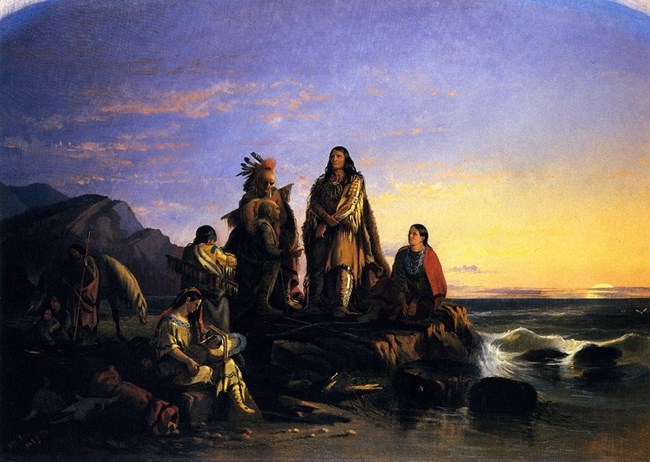Last updated: August 26, 2020
Article
Natawista Iksina (Medicine Snake Woman)
A Powerful Woman, Then and Now

Image courtesy of the U.S. Department of State, Accession # 1965.0053
Natawista, or Medicine Snake Woman, was around 15 when Alexander Culbertson, then about 30, proposed marriage to her family. The story is legendary, the consequences more profound perhaps than those of Sacagawea’s assistance to President Jefferson’s Corps of Discovery.
At the time, around 1840, Natawista and Alexander Culbertson’s marriage was not unusual. Such unions proved beneficial to both husbands and wives. Traders like Culbertson secured trade ties with their wives’ families and tribes, while the wives’ people in turn gained access to and a degree of control over the husbands’ trade goods, relationships, and networks.

Image courtesy of the Friends of John Audubon
Unquestionable is Natawista’s later, crucial role as a cultural and political intermediary. When Isaac I. Stevens, governor of the Washington Territory, led the northernmost transcontinental railroad survey through Blackfoot territory in 1853, Natawista and her husband accompanied him. “Upon joining Mr. Culbertson at Fort Union,” Stevens reported to Congress, “I found him and his wife full of anxiety as to the reception which we would meet from the Blackfeet. They both feared that some rude or careless act from any member of the [survey] party might be a signal for a declaration of war. Full of these apprehensions, Mrs. Culbertson, whom it was intended to leave at Fort Union, declared to her husband her resolution to accompany him with the expedition to Fort Benton. She said to him[,] ‘My people are a good people, but they are jealous and vindictive. I am afraid that they and the whites will not understand each other; but if I go, I may be able to explain things to them, and soothe them if they should be irritated. I know there is great danger; but, my husband, where you go, will I go, and where you die will I die.’”
This is how it was for Natawista. During her long marriage to Culbertson, a man respected by the Upper Missouri tribes as well as the U.S. government, Medicine Snake Woman came to serve as a powerful voice for and representative of her people. In 1851, for instance, Alexander accompanied a delegation of Assiniboine, Hidatsa, Mandan, and Arikara from Fort Union to Fort Laramie in present-day southeast Wyoming. Although the Blackfeet did not attend the Great Council at Horse Creek, some believe Natawista accompanied her husband and through him represented her people. Why? Because the 1851 Treaty of Fort Laramie designated territory for the Blackfeet in the Upper Missouri country.

The Athenaeum (http://www.the-athenaeum.org/)
“She was in constant intercourse with the Indians,” Stevens continued, “and inspired them with perfect confidence. . . . [S]he heard all that the Indians said, and reported it through her husband to me. It is a great mistake to suppose the Indian to be the silent, unsociable people they are commonly represented to be. I found them on ordinary occasions the most talkative, gossiping people I had ever seen. The men and women were fond of gathering around Mrs. Culbertson to hear stories of the whites. One evening I heard shouts of merry laughter from one of these groups. Upon inquiring the source of merriment, I learned that Mrs. Culbertson was telling stories to her . . . Indian friends of what she saw in St. Louis. As she described a fat woman whom she had seen exhibited, and sketched with great humor the ladies of St. Louis, it was pleasant to see the delight which beamed from the swarthy faces around her.”
What Lewis and Clark had learned earlier from Sacagawea, Governor Stevens learned too from Natawista: a woman’s presence, intelligence, and good humor could assure peace and security in times and places where wariness among men alone might have led to war and death. Considering the implications, one wonders, “What would life have been like at Fort Union without the presence of women such as Natawista or Deer Little Woman, the Assiniboine wife of Fort Union’s later Bourgeois Edwin T. Denig? What about life in the country and world today?”
Tags
- fort union trading post national historic site
- natawista
- alexander culbertson
- transcontinental railroad survey
- fort benton
- medicine snake woman
- blackfeet
- 1851 treaty of fort laramie
- womens history
- women's history
- women history month
- women in history
- native american history
- american indian history
- transcontinental railroad
